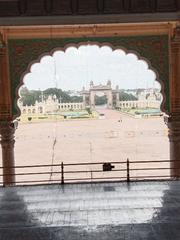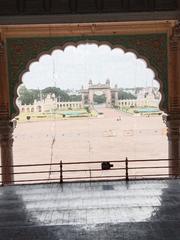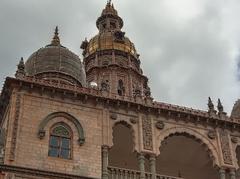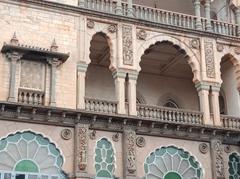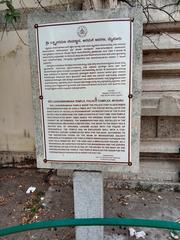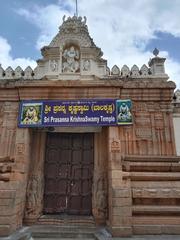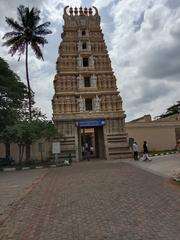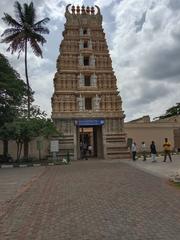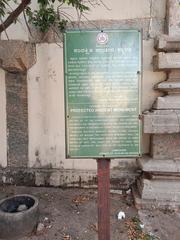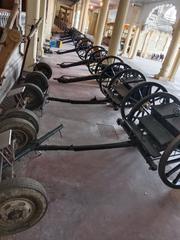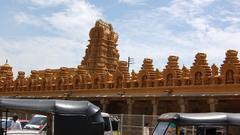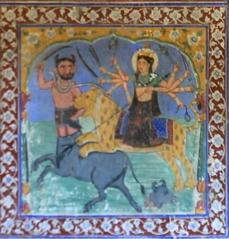
Mysore Palace Visiting Hours, Tickets, and Guide to Mysore Historical Sites
Date: 14/06/2025
Introduction
Mysore Palace, also known as Amba Vilas Palace, stands majestically at the heart of Mysore city and is one of India’s most celebrated royal landmarks. Its captivating blend of Indo-Saracenic architecture, storied history, and vibrant cultural traditions make it a must-visit destination for anyone exploring Karnataka. Originally established in the 14th century and reconstructed in its current form in the early 20th century, the palace reflects the grandeur and cosmopolitan spirit of the Wadiyar dynasty, rulers of Mysore for over five centuries (ExploreBees; mysuruinfrahub.com). Today, it serves as a living museum, a vibrant cultural venue, and a symbol of Karnataka’s royal heritage.
This guide offers a comprehensive overview of Mysore Palace—covering its origins, architectural highlights, visiting hours, ticketing details, accessibility, nearby attractions, and essential visitor tips. Whether you are a history buff, architecture enthusiast, or cultural traveler, this article will help you plan a memorable and enriching experience at Mysore Palace (Karnataka State Open University; vacaywork.com).
Historical Overview
Origins and Early History
The history of Mysore Palace mirrors the rise and resilience of the Wadiyar dynasty. The earliest palace, a simple mud fort built by Yaduraya Wadiyar in the late 14th century, was strategically located facing Chamundi Hills, underscoring the dynasty’s devotion to Goddess Chamundeshwari (ExploreBees; Wikipedia). Over the centuries, the palace was rebuilt and expanded multiple times, with each reconstruction incorporating the architectural influences and aspirations of its era (Travel Earth).
Reconstruction and Architectural Evolution
The palace’s most defining transformation occurred after a devastating fire in 1897, which destroyed the then wooden structure during a royal wedding. Queen Regent Kempananjammanni Vanivilasa Sannidhana commissioned British architect Henry Irwin to design the present Indo-Saracenic structure. Completed in 1912 at great expense, the new palace seamlessly blended Hindu, Muslim, Rajput, and Gothic architectural motifs, resulting in the splendid monument seen today (Karnataka State Open University; Treebo).
Architectural Highlights
Exterior Features
Mysore Palace’s imposing granite facade, crowned with pink marble domes and a soaring central tower, is instantly recognizable (mysuruinfrahub.com). Elaborate arches, intricate carvings, and canopied balconies adorn its exterior. The palace is especially renowned for its grand illumination—nearly 97,000 bulbs light up the structure on Sundays, public holidays, and during the Dasara festival, creating a breathtaking spectacle (mysoretourism.org.in).
Interior Treasures
Inside, visitors are greeted by opulent halls and exquisite artistry:
- Ambavilasa (Diwan-e-Khas): Used for private audiences, featuring stained glass skylights, mosaic floors, gilded columns, and massive Czechoslovakian chandeliers (onceinalifetimejourney.com).
- Public Durbar Hall: Added in the 1930s for ceremonial gatherings, notable for its vivid painted columns and panoramic views (mysuruinfrahub.com).
- Kalyana Mantapa: The octagonal marriage pavilion with a Belgian stained-glass ceiling and a famed peacock mosaic floor (touristsecrets.com).
- Royal Howdah and Artifacts: Contains the golden elephant howdah, royal costumes, weapons, and rare artifacts (onceinalifetimejourney.com).
Temples and Secret Passages
Within the palace complex are twelve Hindu temples, some dating back to the 14th century, reflecting the dynasty’s religious devotion (trawell.in). The complex is also known for its secret tunnels and passages, adding layers of intrigue to its history (mysuruinfrahub.com).
Visiting Mysore Palace
Visiting Hours
- Daily: 10:00 AM to 5:30 PM
- Illumination: Sundays, public holidays, and during Dasara, 7:00 PM to 9:00 PM (InMysore).
Ticket Prices
- Indian adults: ₹70–₹100
- Foreign nationals: ₹200
- Children under 10: Free
- Light and Sound Show: ₹100–₹120 (adults), ₹40–₹50 (children)
Tickets can be purchased at the Varaha Gate or online via the official website (vacaywork.com; thedilli.in).
Accessibility
The palace is wheelchair-friendly, with ramps and free wheelchair rentals available. Braille guides and assistance for visually impaired visitors are offered in select areas (TravelTriangle).
Getting There
- By Air: Mysore Airport (limited flights); Bangalore International Airport (170 km, direct buses available)
- By Train: Mysore Junction (2 km from palace)
- By Bus: KSRTC Bus Station nearby
- Local Transport: Auto-rickshaws, city buses, Uber, and ample paid parking (vacaywork.com)
Entry and Visitor Flow
Most visitors enter through the Varaha Gate (South), deposit footwear and cameras, and exit near the Durbar Hall (vacaywork.com). Modest attire is recommended; footwear must be removed inside.
Facilities and Amenities
- Restrooms & Baby Care: On-site
- Food & Shopping: Snack stalls and Cauvery Emporium for handicrafts
- First Aid: Available
- Audio Guides: Included for foreigners; rental available for Indian visitors in multiple languages (vacaywork.com)
Light and Sound Show
The palace’s Light and Sound Show (7:00–8:00 PM, Thursday to Saturday) narrates the Wodeyar dynasty’s history in Kannada and English. The illuminated palace is a must-see highlight (thedilli.in).
Best Visiting Times and Practical Tips
- Best Times: Early mornings on weekdays for fewer crowds; evenings for the illumination
- Recommended Duration: 2–3 hours for a thorough visit
- Tips: Arrive early, wear comfortable footwear, check for festival schedules, and carry water
Nearby Attractions
- Chamundi Hill & Temple
- Jaganmohan Palace & Art Gallery
- St. Philomena’s Cathedral
- Mysore Zoo
- Devaraja Market
Accommodation Recommendations
- Luxury: Royal Orchid Metropole, Lalitha Mahal Palace Hotel
- Budget: Hotel Siddhartha, Roambay Hostel
Dasara Festival
Mysore Dasara is the city’s most prominent festival, transforming the palace and city with grand processions, folk performances, and dazzling illuminations. The Jumbo Savari (elephant procession) on Vijayadashami is a major highlight (InMysore; DKScore).
Frequently Asked Questions (FAQs)
Q: What are the Mysore Palace visiting hours?
A: Daily 10:00 AM–5:30 PM. Illumination from 7:00 PM–9:00 PM on Sundays, holidays, and during Dasara.
Q: How much are tickets?
A: ₹70–₹100 (Indian adults), ₹200 (foreigners); children under 10 enter free.
Q: Are cameras allowed?
A: Not inside palace interiors. Allowed in gardens/exteriors only.
Q: Is the palace wheelchair accessible?
A: Yes, ramps and wheelchairs are provided.
Q: Best time to visit?
A: Early mornings on weekdays for a quieter experience; evenings for the illumination.
Visitor Etiquette and Safety
- Remove footwear before entering palace interiors and temples.
- Dress modestly out of respect for cultural and religious traditions.
- Follow all security and photography rules.
- The palace is safe and well-patrolled; solo travelers will find it welcoming.
Weather and Health Tips
- Weather: October–March is most pleasant.
- Health: Stay hydrated, use sun protection, and ensure travel insurance.
Additional Resources
For more details on Mysore Palace history, tickets, and visiting information, see:
- ExploreBees
- mysuruinfrahub.com
- TravelTriangle
- vacaywork.com
- Wikipedia
- Travel Earth
- InMysore
- onceinalifetimejourney.com
- Karnataka State Open University
Final Thoughts
Mysore Palace is a magnificent testament to India’s royal past, architectural genius, and living traditions. Plan your visit in advance, respect the site’s rules, and immerse yourself in the unique cultural experience it offers. For enhanced touring, consider downloading the Audiala app for personalized guides, audio tours, and updates.
Prepare for a journey through history, art, and tradition at Mysore Palace!
